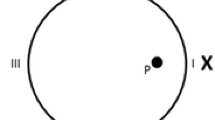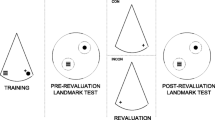Abstract
We tested the ability of number-trained rhesus monkeys to use Arabic numeral cues to discriminate between different series of maze trials and anticipate the final trial in each series. The monkeys’ prior experience with numerals also allowed us to investigate spontaneous transfer between series. A total of four monkeys were tested in two experiments. In both experiments, the monkeys were trained on a computerized task consisting of three reinforced maze trials followed by one nonreinforced trial. The goal of the maze was an Arabic numeral 3, which corresponded to the number of reinforced maze trials in the series. In experiment 1 (n=2), the monkeys were given probe trials of the numerals 2 and 4 and in experiment 2 (n=2), they were given probe trials of the numerals 2–8. The monkeys receiving the probe trials 2 and 4 showed some generalization to the new numerals and developed a pattern of performing more slowly on the nonreinforced trial than the reinforced trial before it for most series, indicating the use of the changing numeral cues to anticipate the nonreinforced trial. The monkeys receiving probe trials of the numerals 2–8 did not predict precisely when the nonreinforced trial would occur in each series, but they did incorporate the changing numerals into their strategy for performing the task. This study provides the first evidence that number-trained monkeys can use Arabic numerals to perform a task involving sequential presentations.





Similar content being viewed by others
References
Beran MJ (2001) Summation and numerousness judgments of sequentially presented sets of items by chimpanzees (Pan troglodytes). J Comp Psychol 115:181–191
Beran MJ, Rumbaugh DM (2001) “Constructive” enumeration by chimpanzees (Pan troglodytes) on a computerized task. Anim Cogn 4:81–89
Boysen ST, Berntson GG (1989) Numerical competence in a chimpanzee (Pan troglodytes). J Comp Psychol 103:23–31
Brannon EM, Terrace HS (1998) Ordering of the numerosities 1–9 by monkeys. Science 282:746–749
Brannon EM, Terrace HS (2000) Representation of the numerosities 1–9 by rhesus monkeys (Macaca mulatta). J Exp Psychol Anim Behav Proc 16:31–49
Burns RA, Criddle CR (2001) Retention of ordinal position information with limited and extended serial training. Psychol Rec 51:445–452
Burns RA, Dunkman JR, Detloff SL (1999) Ordinal position in the serial learning of rats. Anim Learn Behav 27:272–279
Burns RA, Goettl ME, Burt ST (1995) Numerical discriminations with arrhythmic serial presentations. Psychol Rec 45:95–104
Burns RA, Johnson KS, Harris BA, Kinney BA, Wright SE (2004) Functional cues for position learning effects in animals. Psychol Rec 54:233–254
Call J (2000) Estimating and operating on discrete quantities in orangutans (Pongo pygmaeus). J Comp Psychol 114:136–147
Capaldi EJ, Miller DJ (1988) Counting in rats: its functional significance and the independent cognitive processes that constitute it. J Exp Psychol Anim Behav Proc 14:3–17
Capaldi EJ, Miller DJ (2004) Serial learning in rats: a test of three hypotheses. Learn Motiv 35:71–81
Davis H, Bradford SA (1986) Counting behavior by rats in a simulated natural environment. Ethology 73:265–280
Davis H, Perusse R (1988) Numerical competence in animals: definitional issues, current evidence and a new research agenda. Behav Brain Sci 11:561–615
Dehaene S (1997) The number sense. Oxford University Press, New York
Emmerton J (1998) Numerosity differences and effects of stimulus density on pigeons’ discrimination performance. Anim Learn Behav 26:243–256
Gallistel CR, Gelman R (2000) Non-verbal numerical cognition: from reals to integers. Trends Cogn Sci 4:59–65
Gelman R, Gallistel CR (1978) The child’s understanding of number. Harvard University Press, Cambridge
Gulledge JP (1999) Judgments of dot arrays and Arabic numerals by Rhesus macaques: evidence of concept of number. Master’s thesis, Georgia State University, Atlanta
Hauser MD, Carey S, Hauser LB (2000) Spontaneous number representation in semi-free- ranging rhesus monkeys. Proc R Soc Lond B 267:829–833
Hauser MD, Tsao F, Garcia P, Spelke ES (2003) Evolutionary foundations of number: Spontaneous representation of numerical magnitudes by cotton-top tamarins. Proc R Soc Lond B 270:1441–1446
Mandler G, Shebo BJ (1982) Subitizing: an analysis of its component processes. J Exp Psychol Gen 111:1–22
Matsuzawa T (1985) Use of numbers by a chimpanzee. Nature 315:57–59
Olthof A, Iden CM, Roberts WA (1997) Judgments of ordinality and summation of number symbols by squirrel monkeys (Saimiri sciureus). J Exp Psychol Anim Behav Proc 23:325–339
Piazza M, Mechelli A, Butterworth B, Price CJ (2002) Are subitizing and counting implemented as separate or functionally overlapping processes? Neuroimage 15:435–446
Rumbaugh DM, Richardson WK, Washburn DA, Savage-Rumbaugh ES, Hopkins WD (1989) Rhesus monkeys (Macaca mulatta), video tasks, and implications for stimulus- response spatial contiguity. J Comp Psychol 103:32–38
Rumbaugh DM, Savage-Rumbaugh ES, Hegel MT (1987) Summation in the chimpanzee (Pan troglodytes). J Exp Psychol Anim Behav Proc 13:107–115
Smith JD, Shields WE, Washburn DA (2003) The comparative psychology of uncertainty monitoring and metacognition. Behav Brain Sci 26:317–373
Thomas RK, Fowlkes D, Vickery JD (1980) Conceptual numerousness judgments by squirrel monkeys. Am J Psychol 93:247–257
Uller C, Carey S, Huntley-Fenner G, Klatt L (1999) What representation might underlie infant numerical knowledge? Cogn Dev 14:1–36
Uller C, Jaeger R, Guidry G, Martin C (2003) Salamanders (Plethodon cinereus) go for more: rudiments of number in an amphibian. Anim Cogn 6:105–112
Washburn DA (1994) Stroop-like effects for monkeys and humans: processing speed or strength of association? Psychol Sci 5:375–379
Washburn DA, Gulledge JP (2002) A species difference in visuospatial working memory in human adults and rhesus monkeys. Int J Comp Psychol 15:288–302
Washburn DA, Rumbaugh DM (1991) Ordinal judgments of numerical symbols by macaques (Macaca mulatta). Psychol Sci 2:190–193
Washburn DA, Rumbaugh DM (1997) If faster is smarter, why are we slower: a comparative perspective on intelligence and processing speed. Am Psychol 52:1147–1148
Xia L, Siemann M, Delius JD (2000) Matching of numerical symbols with number of responses by pigeons. Anim Cogn 3:35–43
Acknowledgements
This research was supported by a grant (HD-38051) from the National Institute of Child Health and Human Development to the Language Research Center of Georgia State University. The authors would like to thank Michael Beran and Jonathan Gulledge for their advice and assistance in this research. All applicable federal, disciplinary, and institutional rules and regulations regarding animal care and use have been followed in the care and testing of the monkeys
Author information
Authors and Affiliations
Corresponding author
Rights and permissions
About this article
Cite this article
Harris, E.H., Washburn, D.A. Macaques’ (Macaca mulatta) use of numerical cues in maze trials. Anim Cogn 8, 190–199 (2005). https://doi.org/10.1007/s10071-004-0248-5
Received:
Revised:
Accepted:
Published:
Issue Date:
DOI: https://doi.org/10.1007/s10071-004-0248-5




